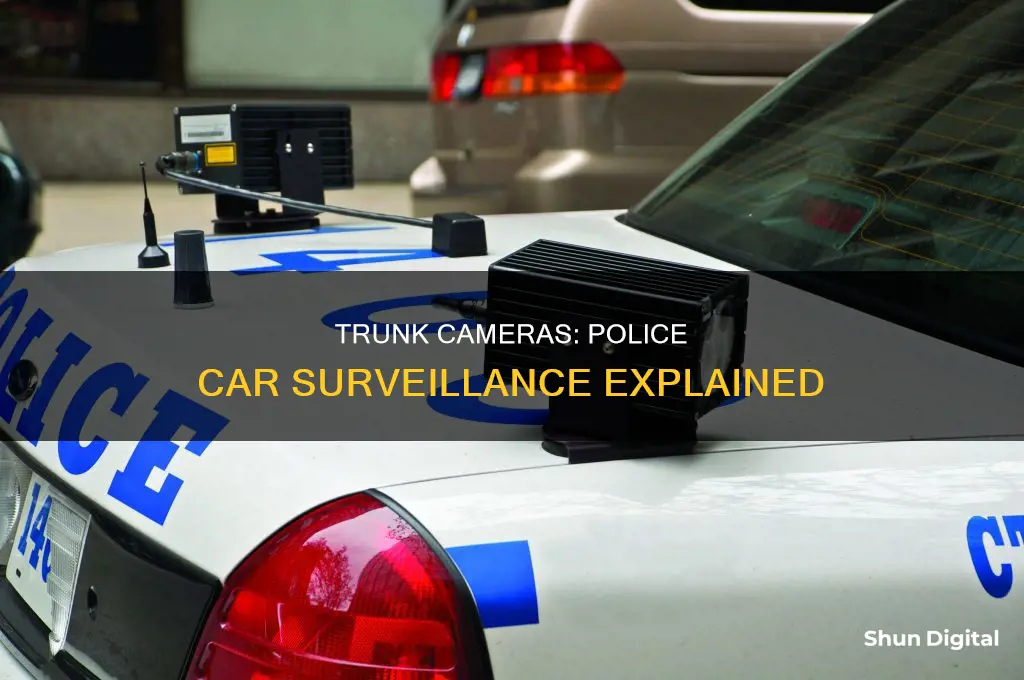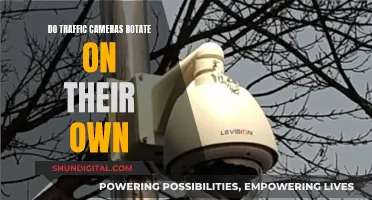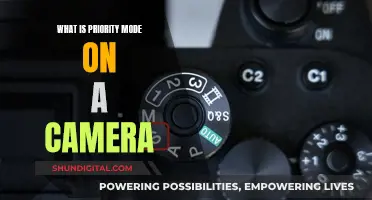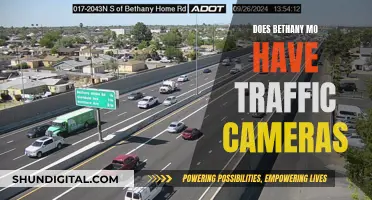
The chunky accessories mounted on the trunks of police cars are cameras used for an automatic license plate reader (ALPR) system. These cameras snap pictures of license plates and a computer in the car looks up the vehicle's registration. The most advanced systems can scan and research up to 1,800 plates a minute, even reading tags on cars racing by at up to 150 mph. The system can run in the background while the officer performs other tasks and alerts the officer with an audible warning and a notification on their computer if it finds a plate of interest.
| Characteristics | Values |
|---|---|
| Purpose | Automatic license plate reader (ALPR) system |
| Number of Cameras | Two |
| Camera Location | Mounted on the trunk or roof of the police car |
| Camera Type | Scanner cameras |
| Functionality | Snap pictures of license plates, and look up the vehicle's registration |
| Capacity | Scan up to 1,800 plates per minute |
| Features | Audible warning and notification on the computer for plates of interest |
| Use Cases | Notify police officers about registration issues, All-points Bulletin (APB), or driver's license restraints |
| Data Retention | Images of non-wanted vehicles are stored for 30 days and then purged |
What You'll Learn

Cameras are part of an automatic license plate reader (ALPR) system
The cameras mounted on the trunks of police cars are part of an automatic license plate reader (ALPR) system. These cameras are used to scan and photograph license plates of nearby vehicles, including those on parked cars, oncoming cars, and cars passing by at high speeds. The system can capture up to 1,800 plates per minute and can even read tags on vehicles travelling at up to 150 miles per hour.
The ALPR system then compares the captured license plate data with information in local, state, and federal databases. If a match is found, the system alerts the police officer with an audible warning and a notification on their computer. This allows officers to identify vehicles with registration issues, All-points Bulletins (APB), or other issues such as a suspended driver's license. The system can run in the background while the officer performs other tasks, providing an efficient tool for law enforcement.
The effectiveness of ALPR systems in crime-fighting has been demonstrated in several cases. For example, in 2017, ALPR data helped locate a car used in a kidnapping and murder case, leading investigators to the culprit. Similarly, during the investigation of the U.S. Capitol riots, ALPR data was used to track the movements of one of the rioters, Dominick Madden of New York City.
In addition to mobile ALPR systems on police vehicles, many towns have also installed ALPR units at toll booths, intersections, and town borders to monitor vehicles entering and exiting the area. These automated units provide an additional layer of surveillance and alert dispatchers when a vehicle of interest is detected.
While ALPR technology has proven valuable for law enforcement, some civil liberties experts have raised concerns about the vast databases of license plate snapshots maintained by private companies that manufacture ALPR systems. The retention and use of this data by private entities is a matter of ongoing debate.
Bridge Cameras: Capturing RAW Images
You may want to see also

The system can scan up to 1,800 plates a minute
The cameras on the trunk of a police car are part of an automatic license plate reader (ALPR) system. These cameras are used to snap pictures of license plates of nearby vehicles, and a computer in the car looks up the vehicle’s registration. The system can scan up to 1,800 plates a minute and can even read the tags on cars racing by at up to 150 mph. It can also snap photos of parked traffic while the police cruiser is moving.
The ALPR system works in tandem with a computer that runs optical character recognition (OCR) software. This software recognizes the characters on the license plate and converts them into a digital format that can be easily searched and compared against a database. The OCR software can also compensate for variations in font size, spacing, and style, as well as differences in lighting conditions and angles between the camera and the license plate.
The ALPR system is connected to local, state, and federal databases, allowing it to check license plates against a vast array of information. If a plate of interest is found, the system alerts the police officer with an audible warning and a notification on their computer. This enables law enforcement to identify vehicles with registration issues, vehicles associated with crimes or suspects, and vehicles with outstanding warrants or APBs.
The high scanning rate of 1,800 plates per minute enables the ALPR system to be effective even in high-traffic areas or when vehicles are moving at high speeds. The system can capture images of license plates in a fraction of a second and process them almost instantaneously, making it a valuable tool for law enforcement in locating vehicles of interest.
The use of ALPR technology has raised some privacy and civil liberties concerns. The vast amount of data collected by these systems can reveal intimate details about individuals' lives, including their travel patterns and locations they frequent. There are also concerns about potential misuse of the data by law enforcement or unauthorized access by third parties. However, supporters of ALPR technology argue that it is a powerful tool for fighting crime and enhancing public safety.
Surveillance Camera Systems: Choosing the Right One for You
You may want to see also

Alerts are sent to the police officer if a plate of interest is found
The cameras on the trunk of a police car are part of an automatic license plate reader (ALPR) system. These cameras scan license plates of nearby vehicles and run them through local, state, and federal databases. If a plate of interest is found, the system sends an alert to the police officer in the form of an audible warning and a notification on their computer. This allows officers to be notified of any issues with a vehicle's registration or if there is an All-points Bulletin (APB) attached to the tag number.
The ALPR system can scan and research a large number of plates in a minute, even reading the tags on cars racing by at high speeds. The system can capture images of parked cars as well as oncoming cars. Each captured plate pops up as an image on a monitor inside the police car, allowing the officer to visually confirm the plate number. If a match is found, the system sounds an alarm and freezes the image of the suspect car on the screen, highlighted in red. A computer-generated voice then announces the specific offense, such as "Stolen car, stolen car, stolen car!"
The use of ALPR systems has proven to be effective in stopping crimes. For example, when an APB is put out on a vehicle suspected in a kidnapping or robbery, the ALPR system can help locate the vehicle quickly. Additionally, data on a suspect's past travels can be used to predict their next move. The system can also be used to notify officers of vehicles with registration issues or if the registered owner has a suspended driver's license.
While ALPR systems have been successful in aiding law enforcement, there are also concerns about privacy and civil liberties. These systems collect data on millions of ordinary people, and this data can be used to track an individual's movements and create a detailed profile of their life. There have been cases where ALPR data has been misused or abused by law enforcement officers, leading to wrongful stops and invasions of privacy.
Concealing Surveillance Wires in a Two-Story House
You may want to see also

ALPR has been proven effective in stopping crimes
The cameras on the trunk of a police car are part of an automatic license plate reader (ALPR) system. These cameras are used to scan license plates and help identify vehicles of interest, such as those with registration issues or All-points Bulletins (APB). ALPR has proven to be effective in stopping crimes and locating vehicles and individuals involved in criminal activities.
ALPR systems have played a crucial role in curbing vehicle-related crimes, which cost the US economy over $8 billion annually. With ALPR, stolen cars can be traced within minutes, and potential threats can be identified and mitigated before they escalate. The technology provides real-time alerts to law enforcement, enabling officers to react promptly and efficiently.
In addition to vehicle recovery, ALPR contributes to crime prevention and investigation in several ways. Firstly, it assists in locating persons of interest, including suspects, victims, and missing persons. Secondly, it aids in ongoing investigations by providing objective data on a vehicle's whereabouts, which can corroborate or disprove witness statements, physical evidence, and confessions. Thirdly, ALPR helps in crime pattern analysis, allowing law enforcement to identify frequent crime locations and predict potential hotspots, enabling data-driven policing strategies.
The effectiveness of ALPR in reducing crime rates is evident from its impact on various types of crimes. For example, in the case of kidnapping or robbery, when an APB is put out on a suspected vehicle, it can often be located quickly using ALPR data. Additionally, data on a suspect's past travels can reveal their next move and assist investigators in predicting their future actions.
ALPR has also proven effective in identifying and apprehending criminals involved in other types of crimes, such as the US Capitol riots. By accessing ALPR data, investigators were able to identify and locate individuals who participated in the riots, even if they tried to hide their identities. This demonstrates the power of ALPR in tracking and apprehending criminals, even in large-scale events with numerous participants.
In conclusion, ALPR has been proven effective in stopping crimes by providing law enforcement with real-time information, aiding in vehicle recovery, locating persons of interest, and assisting in investigations. The technology has improved the efficiency of police work and contributed to a safer society. However, it is important to balance the benefits of ALPR with privacy concerns and ensure that data collection and usage are regulated to protect individuals' rights.
Focusing Camera: Test Your Camera's Focus Accuracy
You may want to see also

ALPR data is stored and can be kept for months or years
The cameras on a police car's trunk are part of an automatic license plate reader (ALPR) system. These cameras are used to capture images of license plates, which are then processed to identify the vehicle. The data collected by ALPRs, including images and vehicle information, is stored and can be kept for extended periods. While some departments may store ALPR data for around 30 days, others maintain databases that store information for months or even years. In some cases, private companies maintain vast databases of ALPR data, which can be accessed by law enforcement agencies.
The retention of ALPR data has raised concerns about privacy and civil liberties. This technology can be used to track individuals' movements and create detailed profiles of their lives, including their travel patterns and locations visited. While ALPRs have proven effective in stopping crimes and locating suspects, the vast majority of individuals whose data is collected are not connected to any criminal activity. The prolonged storage of this data enables ongoing surveillance and can have a chilling effect on First Amendment-protected activities. As a result, there have been calls for regulations and restrictions on the use and retention of ALPR data to balance public safety with privacy concerns.
Max Focus Snake Camera: Capturing Sharp Images with Ease
You may want to see also
Frequently asked questions
The cameras are part of an automatic license plate reader (ALPR) system.
The scanners snap pictures of license plates and a computer in the car looks up the vehicle's registration.
The system warns the police officer with an audible warning and a notification on their computer.
In 2017, ALPR data helped locate a car and gather DNA samples that led to the arrest of a kidnapper and murderer. ALPR data was also used to identify one of the U.S. Capitol rioters.







